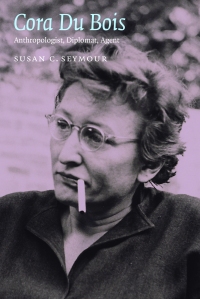 An excerpt from Cora Du Bois: Anthropologist, Diplomat, Agent (May 2015) by Susan C. Seymour.
An excerpt from Cora Du Bois: Anthropologist, Diplomat, Agent (May 2015) by Susan C. Seymour.
CHAPTER 3
Becoming an Anthropologist
[Miss Du Bois’s] PhD examination was unquestionably one of the most brilliant I have ever attended. -A.L. Kroeber
“Open vistas” would be a suitable metaphor for the next stage of Cora Du Bois’s life. Moving to the West Coast in 1929, she not only faced out across the Pacific but, as she later reported, she also learned to look outward. Berkeley and the San Francisco Bay Area were filled with hills and mountains so that one could climb up and view the landscape from a perspective that she had not experienced in the East.1 The vistas were huge and open. At the same time, the study of anthropology provided Cora with a broad, new intellectual vista—a view of the world, and its many different cultural inhabitants, throughout time and space. For the rest of her life, she would savor these years of study and exploration.
After arriving in Berkeley in early January 1929, Cora wrote to her mother providing her new address—a family hotel on Telegraph Avenue, one block from the university—and her first description of her new locale: “The town is nice enough; the campus quite lovely; the weather even more admirable than a native son paints it. Roses and callow lilies, spring clothes and what not. Lowie and Kroeber have been charming. They gave me long and personal attention. The technicalities here are just as bad as at Columbia but at least Lowie and Kroeber do all they can to minimize them.”2
In coming to the University of California at Berkeley for graduate work in anthropology, Cora was joining the westernmost branch of a relatively new discipline in the United States. In 1901 UC Berkeley established the first anthropology program west of the Mississippi and hired Alfred Louis Kroeber as the program’s first instructor and curator-custodian of what would become, much later, the Phoebe A. Hearst Museum of Anthropology. Kroeber, Franz Boas’s first graduate student, had, in 1901, just completed a PhD in anthropology at Columbia. Like his mentor and many other early anthropologists, he would become intensively involved with simultaneously doing ethnography, collecting cultural artifacts, publishing, managing a museum, and building an academic program. And like its counterparts elsewhere—Harvard, Columbia, the University of Pennsylvania, and the University of Chicago—UC Berkeley’s anthropology program would be closely linked with the establishment of a museum, in this case one to house, initially, its benefactor’s collection.
Phoebe Apperson Hearst—a wealthy San Francisco philanthropist, UC regent, and the mother of William Randolph Hearst—provided the funds with which to build a temporary “museum” at the university, pay the salaries of two anthropologists, and underwrite some local and international archaeological and ethnological research expeditions. In addition, she covered the part-time salary for Frederic Ward Putnam, the famed director of Harvard University’s Peabody Museum of Archaeology and Ethnology, to serve temporarily—and mostly in absentia—as director of the new museum. The first museum building, which was intended to be temporary but which lasted nearly sixty years, was a sixty-by-eighty-foot, two-story warehouse built of corrugated iron and known as the “Tin Bin.”3
By the time Cora arrived in the spring of 1929, the museum had been moved to San Francisco and the Tin Bin turned into the Anthropology Department offices, library, and classrooms.4 The anthropology faculty had grown from two to three and one-half positions, now funded by the university, with additional monies provided for visiting anthropologists, research fellows, and some limited fieldwork by graduate students. Kroeber was chair of the department and director of the museum. Robert H. Lowie, another Boas-trained anthropologist from Columbia, and Edwin Meyer Loeb, with a degree from Yale, were the other two full-time professors of anthropology. Edward Winslow Gifford served as the museum curator and a part-time instructor. It was a small and intimate program situated in an unusual but intimate space.
Cora’s first meeting with Alfred Kroeber was memorable. Kroeber was fifty-three and, by then, a renowned anthropologist and administrator, who, like his own mentor Boas, was somewhat Germanic and authoritarian in style. He asked Cora what she was interested in, and she responded, “You know, I have been reading Oswald Spengler’s Decline of the West and am much influenced by him. I think this is an important but not a definitive book, but it is eventually the kind of thing I want to do. Meanwhile, I realize that I have to acquire a certain amount of technical training in anthropology, so I’m perfectly willing to sit down and do any ethnography [written description of a culture] that you think I should do.” And Cora continued with her reminiscences: “I still remember Kroeber, who was quite a handsome man, with a short gray beard. He was sitting in what we called the Tin Bin—an old storage shed that had been turned into the Department of Anthropology. He sat there, stroking his beard, which was a very characteristic gesture, and looking out the window, doing his damnedest not to laugh.”5
NOTES
Epigraph: Excerpt from A. L. Kroeber, letter of recommendation for Cora Du Bois, December 9, 1932, RDA, “Du Bois, Cora 1928–1938,” Series 4, Subseries 4, Box 51, CU-23.
1. Cora Du Bois, personal communication.
2. January 12, 1929, letter home, cdb h, Box 1.
3. See T. Kroeber, Alfred Kroeber; and Jacknis, “First Boasian.”
4. The museum was housed on campus once again when new buildings for it and the Department of Anthropology were erected in 1959. At that time the museum was named in honor of Robert Lowie.
5. This is a compilation of Du Bois’s remarks from two interviews: JW, Session I, Pt. 1; and Lawrence C. Kelly, interview with Cora Du Bois, CDB H, Box 11.
